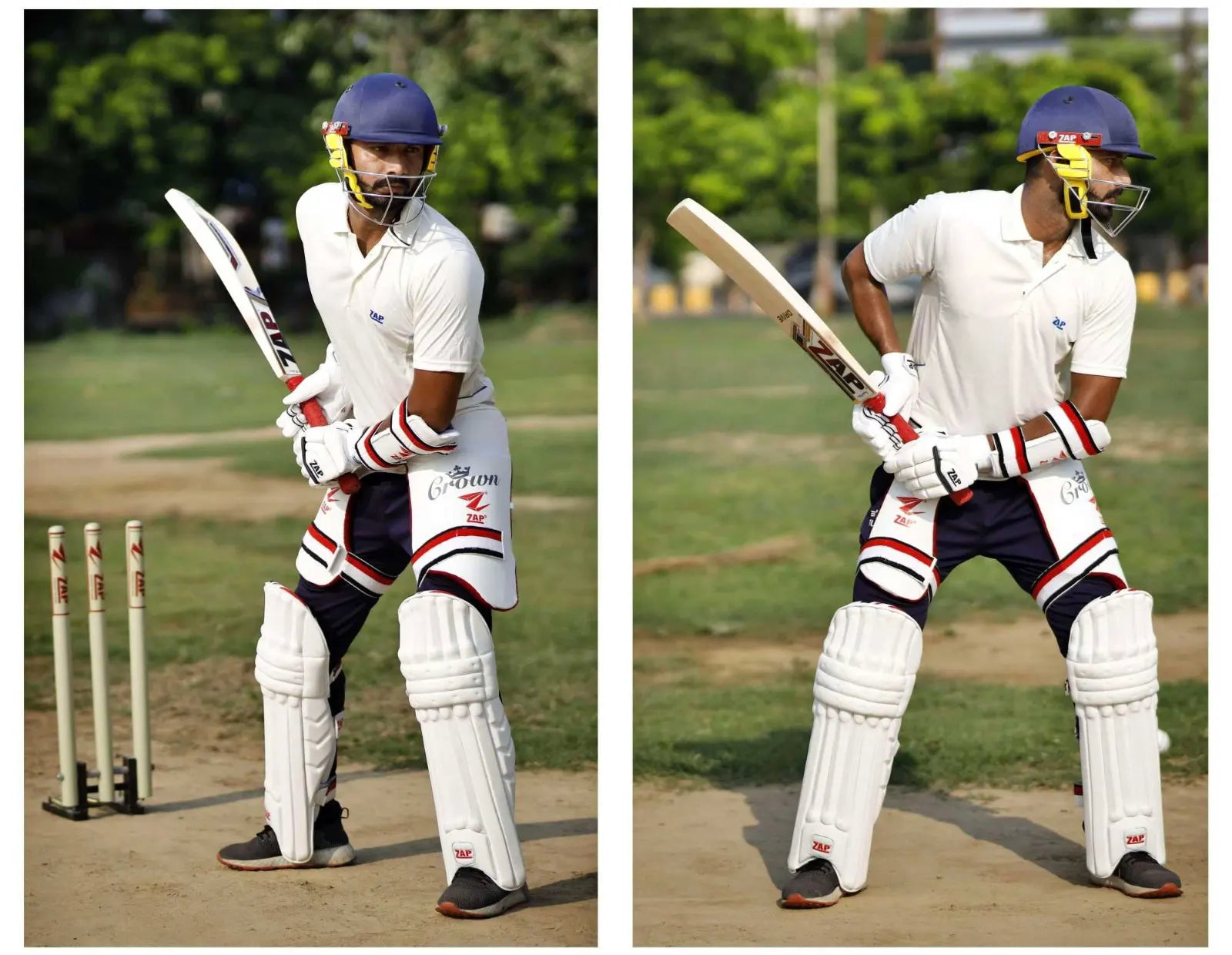While batting in cricket, having the right stance is like laying down a strong foundation for a confident shot making. It allows you to be in a state of maximum comfort before facing a bowler’s delivery. Your cricket batting stance enables you to be relaxed and helps in balanced shot making, allowing you to exhibit power, precision and confidence with the bat on the pitch.
There are various positions you can choose to stay before facing the ball, but there are some standards in cricket that make up the right batting position in cricket. In this chapter of Learn with ZAP, know the right batting pose and own the pitch with the bat in hand.
Getting the Basics Right
Nobody has the perfect batting stance right from the get go, you can always improve upon it to make it better. Though it is always said that you should stay in a position that is comfortable to you but comfort does not always match up to efficiency. Your posture should be such that you are comfortable, while also being super systematic. Here’s what your stance should liberate you to do:
- You should be able to swiftly move from the stance.
- You should be able to hit shots in all directions.
- You should be able to hit the ball with power.
- You should be able to play against spin bowling.
- You should be able to transfer weight on either of your feet effectively. (Very important)
Along with your posture, the bat you hold in your gloves gives your equal confidence. Get yourself a ZAP Cricket Bat and start dominating the game!
Here’s a cricket batting stance diagram for you to understand everything better:

Credit: Saikrishna’s Newsletter
Elements of an Ideal Batting Stance:
-
Feet Positioning
Your feet position is an important element that adds balance to your pose and helps you change the height when facing the ball. The wider your feet go, the lower your centre of gravity and the greater your balance., but be careful not to go wide beyond a level that’s not comfortable. Lower centre of gravity is important to play on a cricket pitch where there’s less bounce, while a straight upright position is ideal for bouncy pitches, or a tennis ball batting stance.
-
Knee Bend
A flexed knee adds stability and flexibility to your body posture. This position enables you to adjust to various types of deliveries and play shots correctly, with the right timing and power. Get yourself a pair of batting pads, that are flexible and lightweight and will help you be comfortable on the pitch.
-
Body Alignment
Ideally, your position should be such that your body is sideways to the bowler, with your shoulder facing and head facing him. This position will provide you with a clearer view of the leather ball and allows you to judge the line and length accurately.
-
Grip on the Bat
Have your non-dominant hand, at the top and the lower dominant hand at the bottom. The top hand gives your shot the direction, while the bottom hand generates and adds power behind it. Hold your bat with a firm yet relaxed grip. Have your fingers wrapped the handle completely, and this will give you better control over the bat swing and help in accurate shot placement. Have a top quality rubber grip over your bat's handle have a confident wrist work with your wooden willow.
-
Head Position
Head position is one of the most important aspects of an impeccable batting technique. Head being the heaviest part of your body, if it is not aligned with your body, you’ll have an imbalanced shot. Also, always keep your focus on the bowler's bowling hand, so you can spot any bowling variation that the bowler might bowl. Wear a helmet, that provide you with with an uninterrupted view of the ground and the bowler, while also giving you a titanium like protection.
-
Backlift
As the bowler approaches the crease, lift your bat up behind the backfoot in a controlled and balanced way to maintain balance and timing. Don’t raise it excessively, as it may not be able to bring the bat down in time to defend against some balls. For a good backlift, work well on your forearms and wear an elbow guard that protects well and feels super light.
-
Stance Variation
Adjusting and adaptation is key to an excellent and effective technique. So vary your stance a bit based on what kind of bowlers and pitch condition you are playing in. For spinners on a turning track, it is necessary to go lower, while for pacer on a bouncy pitch, stay tall and cover the bounce.
Common Batting Stances in Cricket:
The Classic Front-Foot Stance

- This stance is used by most batters and involves a perpendicular alignment of your body. The front toes of both, your front foot and the back foot are in the same line with each other.
- The positives of this stance is that it allows exceptional balance and stability and is perfect for players who play strokes along the ground in a V.
The Aggressive Back-Foot Stance

Credit: Saikrishna’s Newsletter
The Open Stance:

Credit: ESPN Cricinfo
The Wide Stance

Credit: Crictracker
- In the wide stance, you keep your legs separated more than usual and create a wide and evident distance between your front and backfoot.
- This position is ideal against spinners. It can give you an advantage to shift your weight easily on the front foot or the backfoot.
Tips to always remember:
- Regularly analyze your batting pose and evolve with time to get better or more suited to the changing play style. Remember in 2014, when Virat Kohli’s batting stance was a complete disaster in the test matches in England? The next series, he worked hard on developing a better one and came over his shortcomings and became the best batsman in the series.
- Mental focus is the key. Always be focused on the match, with your eyes always on the leather.
Batting Stance Techniques Used by Legendary Batsmen
-
Sir Don Bradman's Compact Stance

Credit: The Sydney Morning Herald
Sir Don Bradman, the greatest batsman of all time, had a unique and compact stance. He kept his feet close together, and played lethal fast bowling in his time bravely.
-
Brian Lara's Graceful Backlift

Credit: ESPN Cricinfo
Brian Lara's batting stance was a sight to behold. With an elegant backlift and a slightly open stance, he could dispatch bowlers to all parts of the ground with ease.
-
Sachin Tendulkar's Still Head

Credit: India Today
Sachin Tendulkar's technique was too beautiful, and his head remained incredibly still during the bowler's run-up. This allowed him to pick up the line and length early and play shots with impeccable timing.
-
Ricky Ponting's Front-Foot Dominance

Credit: Screengrab from Cricket Australia
Ricky Ponting's stance emphasized a strong front-foot presence. This approach allowed him to play powerful drives and pull shots, making him formidable with the bat.
-
Virat Kohli's Well-Balanced Stance

Virat Kohli's stance exemplifies perfect balance. His ability to shift weight effortlessly enables him to play shots on both sides of the wicket with tremendous control.
FAQ:
Q - Which is the best cricket batting stance?
There is no best cricket standing position, just read about the above tips and points and select and modify your pose that feels comfortable and adds functionality in your batting techniques.
Q - What role does the grip on the bat play in the batting stance?
Your grip on the bat influences your control and shot execution and the right one allows you to play a wide range of strokes with precision and power.
Q - How can I improve my balance in the batting stance?
Focus on distributing your weight evenly between both feet, and ensure your head is steady and in line with the body. Regular practice and fitness training can also contribute to better balance.



Share:
Cricket Pitches: Understanding the Types and Characteristics of the Surface
How to play the Square Cut Shot in Cricket Perfectly?
5 comments
Look like batter
Get into football lads
I bought a one million pound bat.
I bought a one million pound bat.
It’s
Perfect explaination